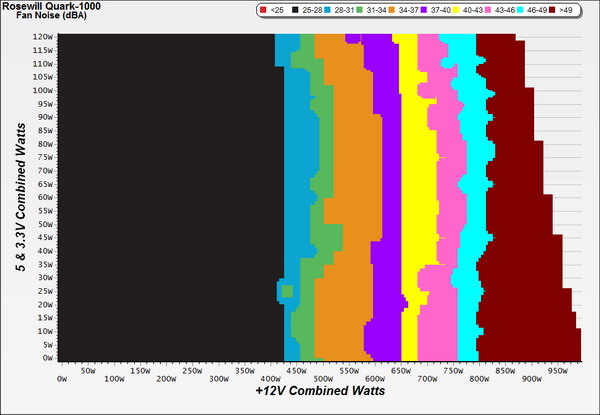Rosewill Quark 1000 Power Supply Review
Today we take a look at Rosewill's Quark 1000. In addition to 80 PLUS Platinum efficiency and fully modular cabling, this $200 unit can support multiple GPUs.
Why you can trust Tom's Hardware
Efficiency, Temperatures And Noise
Efficiency
Our efficiency testing procedure is detailed here.
Using the results from the previous page, we plotted a chart showing the Quark 1000's efficiency at low loads and at loads from 10 to 110 percent of the PSU's maximum-rated capacity.
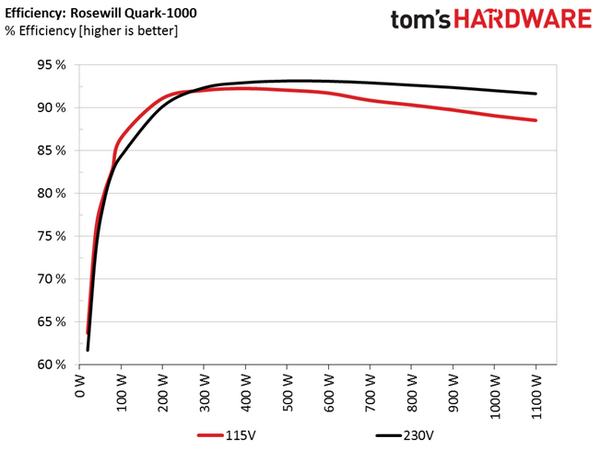
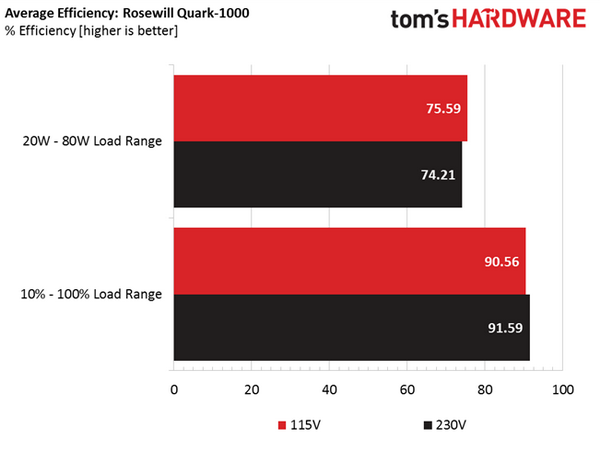
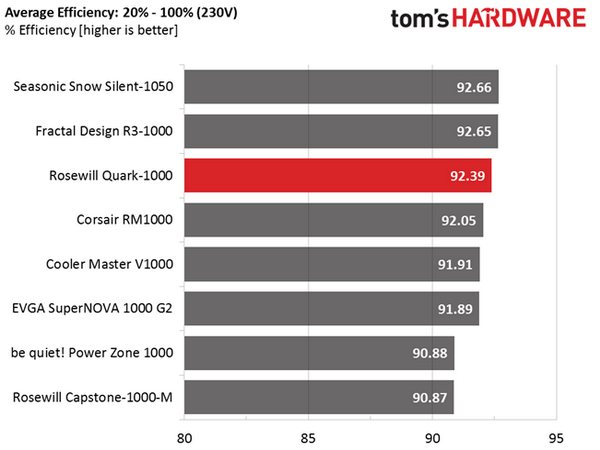

This Enhance Electronics platform proved to be highly efficient at normal loads. It didn't stand a chance at light loads though, even against the Gold-rated competition. We would like to see higher efficiency readings with less than 100W loads.
Efficiency At Low Loads
In the next tests, we measure the efficiency of the Quark 1000 at loads significantly lower than 10 percent of the device's maximum capacity (the lowest load the 80 PLUS standard measures). The loads we dialed were 20, 40, 60 and 80W. This is important for representing when a PC is idle with power-saving features turned on.
| Test # | 12V(A/V) | 5V(A/V) | 3.3V(A/V) | 5VSB(A/V) | Power DC/AC(W) | Efficiency(%) | Fan Speed(RPM) | Fan NoisedB(a) | PF/AC (V) |
|---|---|---|---|---|---|---|---|---|---|
| 1 | 1.209A | 0.491A | 0.477A | 0.198A | 19.61 | 63.71 | 590 | 27.3 | 0.845 |
| 12.050V | 5.008V | 3.340V | 4.998V | 30.78 | 115.0V | ||||
| 2 | 2.447A | 0.989A | 0.986A | 0.400A | 39.72 | 75.76 | 640 | 28.0 | 0.893 |
| 12.047V | 5.005V | 3.339V | 4.991V | 52.43 | 115.0V | ||||
| 3 | 3.686A | 1.487A | 1.496A | 0.600A | 59.82 | 80.01 | 720 | 33.6 | 0.927 |
| 12.044V | 5.002V | 3.338V | 4.984V | 74.77 | 115.0V | ||||
| 4 | 4.916A | 2.002A | 1.976A | 0.800A | 79.76 | 82.87 | 870 | 36.1 | 0.939 |
| 12.039V | 4.999V | 3.335V | 4.975V | 96.25 | 115.0V |
At light loads with 115V input, efficiency is higher than with 230V. However, we expected even better results from a Platinum-rated unit based on a modern platform.
5VSB Efficiency
The ATX specification states that 5VSB standby supply efficiency should be as high as possible, recommending 50 percent or higher with 100mA of load, 60 percent or higher with 250mA of load and 70 percent or higher with 1A or more of load.
We will take four measurements: one at 100, 250 and 1000mA each, and one with the full load the 5VSB rail can handle.
Get Tom's Hardware's best news and in-depth reviews, straight to your inbox.
| Test # | 5VSB (A/V) | Power DC/AC (W) | Efficiency (%) | PF/AC (V) |
|---|---|---|---|---|
| 1 | 0.102A | 0.50 | 71.43 | 0.048 |
| 4.933V | 0.70 | 115.0V | ||
| 2 | 0.252A | 1.24 | 74.70 | 0.11 |
| 4.928V | 1.66 | 115.0V | ||
| 3 | 1.002A | 4.91 | 83.36 | 0.301 |
| 4.904V | 5.89 | 115.0V | ||
| 4 | 2.502A | 12.15 | 80.95 | 0.456 |
| 4.855V | 15.01 | 115.0V |
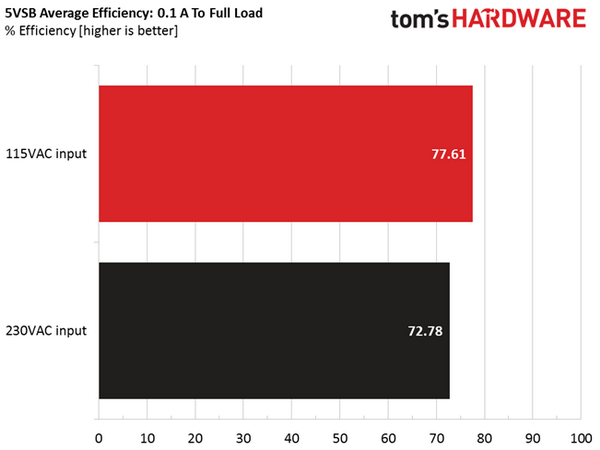
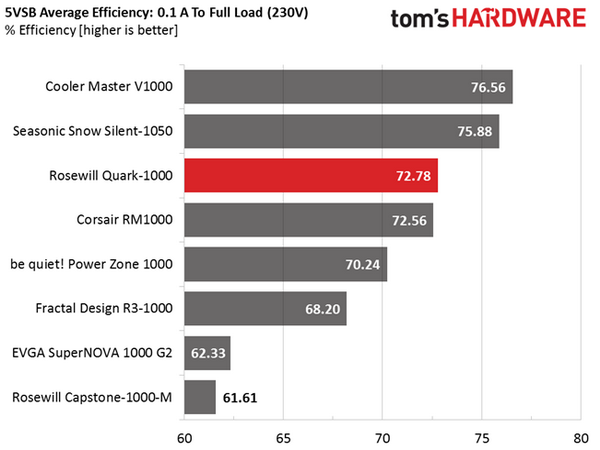
The Quark 1000 features a highly efficient 5VSB rail. However, it does not compare with Seasonic's high-end platforms.
Power Consumption In Idle And Standby
| Mode | 12V | 5V | 3.3V | 5VSB | Power (AC) | PF/AC (V) |
|---|---|---|---|---|---|---|
| Idle | 12.049V | 5.010V | 3.342V | 5.010V | 8.70W | 0.51 |
| 115.0V | ||||||
| Standby | 0.07W | 0.005 | ||||
| 115.0V |
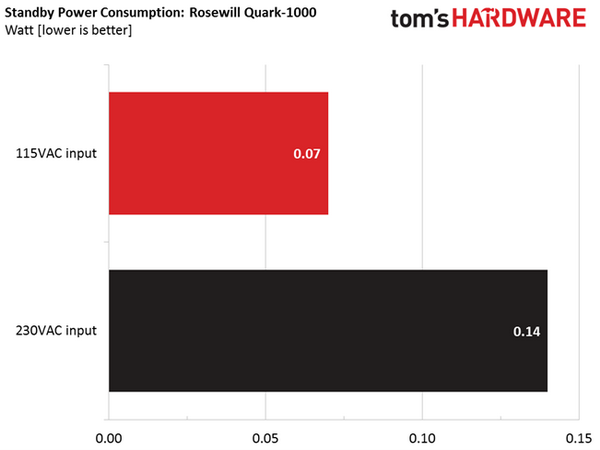
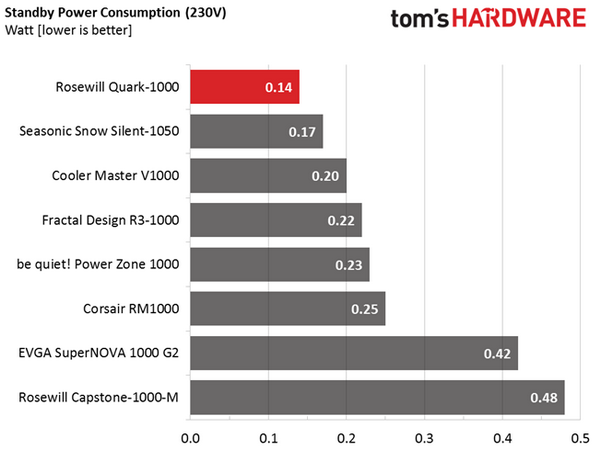
In the table above, you'll find the power consumption and voltage values of all rails when the PSU is idle (powered on, but without any load on its rails), and the power consumption when the PSU is in standby (without any load at 5VSB).
Phantom power was very low with both 115V and 230V inputs. This surely played a significant part in the 5VSB rail's high efficiency.
Fan RPM, Delta Temperature And Output Noise
Our mixed noise testing is described in detail here.
The following chart illustrates the cooling fan's speed (RPMs) and the delta between input and output temperature. The results were obtained at 36 to 47 °C ambient temperature. The next chart shows the cooling fan's speed (RPMs) and output noise. We measured acoustics from one meter away, inside a small, custom-made anechoic chamber with internals completely covered in soundproofing material (be quiet! Noise Absorber kit). Background noise inside the anechoic chamber was below 18 dB(A) during testing, and the results were obtained with the PSU operating at 36 to 47 °C ambient temperature.

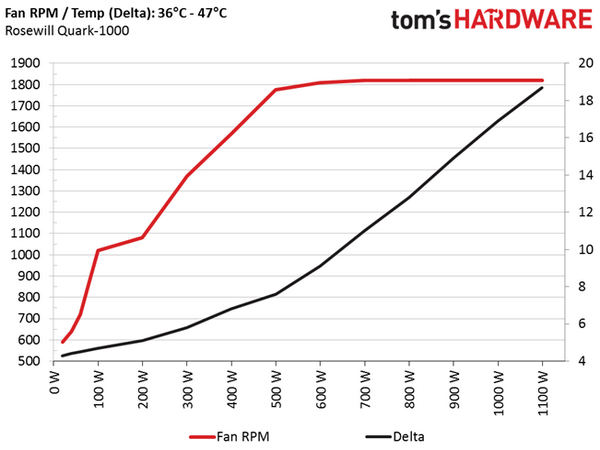
Up until around 500W, the PSU showed silent operation. But it quickly reached loud levels after that, and became downright annoying with more than 800W of load. Considering its high efficiency and the large heat sinks, we expected a more relaxed fan profile. We suspect that Rosewill wanted to ensure adequate cooling of the +12V MOSFETs, which are partially cooled by the unit's chassis.
Current page: Efficiency, Temperatures And Noise
Prev Page Load Regulation, Hold-Up Time And Inrush Current Next Page Cross-Load Tests And Infrared Images
Aris Mpitziopoulos is a contributing editor at Tom's Hardware, covering PSUs.
-
ern88 I don't know of Rosewill is any better then it was a few years ago. I had friends with a rosewill PSU and it baked big time. Maybe they are better now. But I would stick with EVGA or another well known good company!!!Reply -
justaguywithagun i wouldnt hesitate to replace my ~7y/o antec TP750 with a nice rosewill capstone unit when the time comes. in fact, thats essentially my plan. would i throw any rosewill unit in my rig/s? no i wouldnt, but every manufacturer i can think of has units that are less than desirable. rosewill has a come a long long way the last few yearsReply -
Larry Litmanen ReplyI don't know of Rosewill is any better then it was a few years ago. I had friends with a rosewill PSU and it baked big time. Maybe they are better now. But I would stick with EVGA or another well known good company!!!
Obviously EVGA has amazing brand name and they deserve it because of their level of service. However as far as i know EVGA does not have any PSU making plants, they simply rebrand a unit made by Seaconic or another OEM. Many companies do that, so you can probably buy exactly the same unit from a different brand.
I am not sure if Rosewill builds or rebrands, but i had their products and they are not bad, i personally have not had any issues. -
Aris_Mp Several Rosewill PSUs are build by Super Flower, the same OEM that also makes most of EVGA's offerings.Reply -
none12345 "I don't know of Rosewill is any better then it was a few years ago. I had friends with a rosewill PSU and it baked big time. Maybe they are better now. But I would stick with EVGA or another well known good company!!! "Reply
I duno if their large ones are as good. But ive had a 550 watt running in this computer for 6.5 years now with no problem. This is the first roswell one i had tried. Thats the longest ive ever stayed on the same power supply.(In the past it was either fry, or had to upgrade the size because of ever increasing component power usage) -
Aris_Mp Like every company that wants to do well into this market Rosewill doesn't rely on only one manufacturer. They had strong ties with Super Flower in the past however they decided to go with other OEMs as well, since SF became so popular and cannot meet the demands of all the companies that want their products.Reply -
Shalmaneser Does anyone actually do OCP, OVP, OPP / OLP, OTP, UVP, SCP, andReply
NLO? (Something of a rhetorical question), short answer from google is no...
Also, why is the list graphical? I'd like to have a character list to search through...
